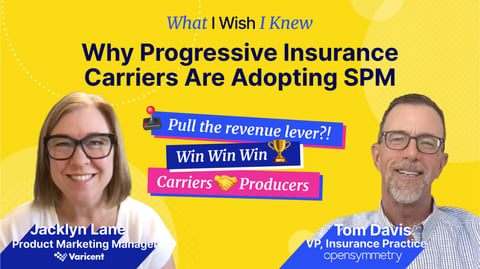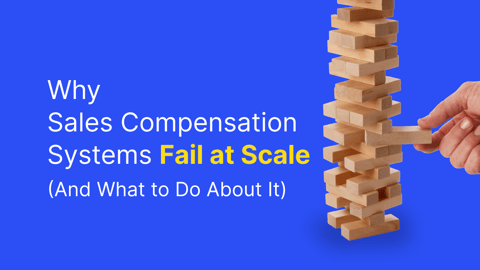Motivating your workforce is the most critical responsibility for any manager or VP, and it can have the greatest impact on the business's success.
Employees in customer-facing roles and the sales function are responsible for ensuring that a company delivers on its customer commitments. Those engaged directly in sales have the additional – and formidable – challenge of understanding and anticipating the needs of their customers and prospects, making sure they can meet them, and fending off competitors.
Engaging with customers is demanding but central to a business’s success. Keeping your employees focused and motivated on what matters is vital. Unsurprisingly, compensation management plays a significant role in achieving that. But thankfully, the best compensation management software can help you get the results you desire.
Let's explore compensation management in more detail and see how the right software helps you enhance employee engagement and grow your business.
What is Compensation Management Software?
Compensation management software helps managers and HR professionals design an ideal compensation management program(s) so that the performance and behavior of employees are closely aligned with the business’s needs. Compensation management applications can help employees understand how they’ll be rewarded in terms of base salary, commissions, and bonuses over the year.
For those outside of sales on a bonus plan, these applications can show the variables they can influence to meet their bonus objectives - whether customer satisfaction, expense management, or company profitability. These applications can help salespeople understand their potentially complex compensation packages, objectives, and rules around selling new products or using clawbacks. Based on their existing sales pipeline, they can see their year-to-date performance and what they can expect to earn.
The value of compensation management applications is their ability to automate this process to reduce the workload of managers, employees, and HR teams so that they can focus on more valuable activities.
Compensation management solutions can cover a broad array of areas but typically provide a centralized system that covers the following:
- Compensation planning
- Incentive programs
- Process automation
- Employee performance monitoring
- Creating compensation statements
A compensation management solution often integrates into the employee payroll process so that the correct commission and bonus payments are made accurately, on time, and with minimum manual intervention. This centralized approach to compensation management helps automate the compensation workflows, whether designing the ideal compensation plans or allowing your HR team to understand how your compensation models and compensation practices fit into their global salary benchmarking models and talent management planning.
The Benefits of Compensation Management Software
The value of compensation management software is significant for HR teams, managers, and employees. The ideal solution can help you automate and streamline your compensation management process from design, review, refinement, and delivery to ongoing management. It supports the compensation review process for the following years so that HR teams and managers can create different compensation strategies to get the most from their budget. Specialized applications can help them develop employee compensation packages that attract, retain, and motivate the skilled employees that their business needs in a competitive world.
The Key Features of Compensation Management Software
Let’s look at some of the key features of a compensation management platform:
A Centralized Database
A challenge with many compensation management processes is that they use a mix of ad hoc systems held together by the ingenuity and determination of the HR team. There might be an HR system here, some documents there, and in the middle, multiple spreadsheets that inevitably pop up as people try to make ad hoc processes work effectively.
Compensation management software combines all the elements needed into a centralized database; for example, employee data, compensation plans, compensation costs, data on other employee benefits, and data about equity plans. They may also form the basis of a business's tax and benefits management programs. These applications are the foundation of the compensation management framework that a company will include as part of its overall business plan.
A Cloud-based Application
Another feature of modern compensation management systems is that they’re typically cloud-based applications, which are easier to buy, implement, and use compared to those used just five years ago. Cloud-based (or SaaS-based) applications reduce or even eliminate the need to involve the IT function in rolling out a compensation management project. This helps reduce project costs and timescales, as well as the need to recruit costly IT staff and project managers.
Application Integration
These applications can also be integrated into various business systems to seamlessly capture data that the HR team and business managers must draw upon to create sophisticated compensation plans. The ideal compensation model for your business should also integrate seamlessly into your payment systems to ensure that people are paid accurately and on time, providing an efficient and streamlined process back to the company.
Choosing the Right Compensation Management Software for Your Organization
It’s critical to choose the right compensation management software for your business. The choice will likely depend on the nature of your customer engagement and sales processes, especially the scale and complexity. Choosing the right one to help design the right compensation strategy and plans can give you the edge you need to attract and retain the right staff to succeed.
Sales compensation management isn't simply about getting the correct commission rate or bonus structure; it’s about helping to get results for the business. To do that, you must ensure that you have realistic quota and bonus models for your employees. Getting the right quota and bonus models means understanding your target market well so you know how large the potential opportunity is. This will help ensure your sales territories are sized correctly, so you know how many salespeople you need and the blend of skills they’ll need.
This insight can inform your compensation planning; you’ll have everything you need to develop a robust compensation management model. Setting impossible targets demotivate employees, and they’ll head for the door. Setting targets that are too easy to achieve will impact profitability. Having a data-driven model helps you balance this year in and year out.
Something else to think about is the ease of deployment. For many businesses, the need for speed means they have to act faster than their IT function can support, which may mean a sales function or an HR team needs to move ahead with a compensation management project without them. SaaS-based computing capabilities make doing this much easier than before, meaning that non-IT staff can safely deploy applications without needing specialist expertise. Data integration can be easy, too, whether you need to pass payment information for the next payroll date or pull data from your finance, CRM, and eCommerce platforms.
Automated data analytics can also be useful for a compensation management platform. Designing the right compensation plan requires understanding a range of variables, such as market opportunity, how customers buy, the length of a typical sales cycle, how often customers upgrade a product or service, and more. Automating the analytics process helps you make sense of a large, complex data set and generate various compensation options.
Implementing Compensation Management Software: Best Practices
Taking a sophisticated - and hugely valuable - approach to developing a compensation management framework isn't just a case of clicking the 'Start' button. A successful project needs the proper support from the business. The key players in the industry - and the project team itself - must be drawn from the HR and sales functions. They’re best positioned to understand the current systems, processes, and requirements, where the shortcomings are currently, and ultimately what ‘good’ might look like.
The next step is to plan the implementation and system integration. This is much easier in a modern SaaS-based environment than it used to be. It’s a case of setting up the application online, then installing employee data, salary information, and a compensation model. After that is a case of integrating the different data sources you want to use to define issues like your sales territories. With that information in place, the platform can analyze your data and provide insights that help you develop the ideal compensation model.
The next step is the most challenging for any business: user adoption. Getting users across the business to use the platform is critical. If they don't use it or find ways of working around it, the company won’t capture the value laid out in the business case.
User adoption plans often feature a range of components:
An Internal Launch
Here, the company and the teams directly impacted are briefed on the project and the benefits it will give them. This might involve a series of events, webinars, blog posts, or emails that tell a consistent story about why the business is implementing the solution.
User Training
User training is also vital so people understand the platform, how to use it, and the business’s expectations. User interfaces have become much more intuitive in recent years, which helps people adapt to new systems quickly.
Special training is needed for users who will use the high-end functionality to perform tasks like data analytics and report generation or are likely to use the insights for decision support.
The Future of Compensation Management Software
The future of compensation management software is likely the same as other types of applications a business uses. It must consistently add value by streamlining a range of processes to reduce costs, eliminate errors, and empower users to tackle complex challenges. Not to mention, all this needs to be possible without hiring additional data scientists, project managers, and other resources that can make a project time-consuming and expensive.
Get the best practices for adopting a sales performance management solution, and what functionalities will be best suited for your team in our Sales Performance Management Buyer's Guide.



